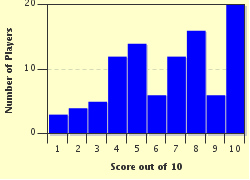Quiz Answer Key and Fun Facts
1. Phosphorus has an atomic number of 15 but it is sometimes referred to as the 13th element. Why is this?
2. The atomic symbol for phosphorus is which of the following?
3. Which of the following statements about phosphorus is NOT true?
4. White phosphorus glows in the dark as it spontaneously emits light when it is oxidized. This was orginally called phosphorescence but is now known by which name?
5. Phosphorus was discovered around 1669 by the alchemist Hennig Brandt. What was he trying to find?
6. What material was Hennig Brandt working with when he discovered phosphorus?
7. Elemental phosphorus is highly toxic. Many early workers in the matchmaking industry who were chronically exposed to it suffered an affliction commonly known as what?
8. White phosphorus is a pyrophoric substance, which means which of these?
9. Phosphorus is the sixth most abundant element in the human body (by mass). It is considered a _______ ?
10. Extensive use of phosphorus as a fertilizer has led experts to believe that sometime over the next 50-300 hundred years, the existing supply will be exhausted. What measure has been widely suggested as a solution to this shortage?
Source: Author
namrewsna
This quiz was reviewed by FunTrivia editor
WesleyCrusher before going online.
Any errors found in FunTrivia content are routinely corrected through our feedback system.

